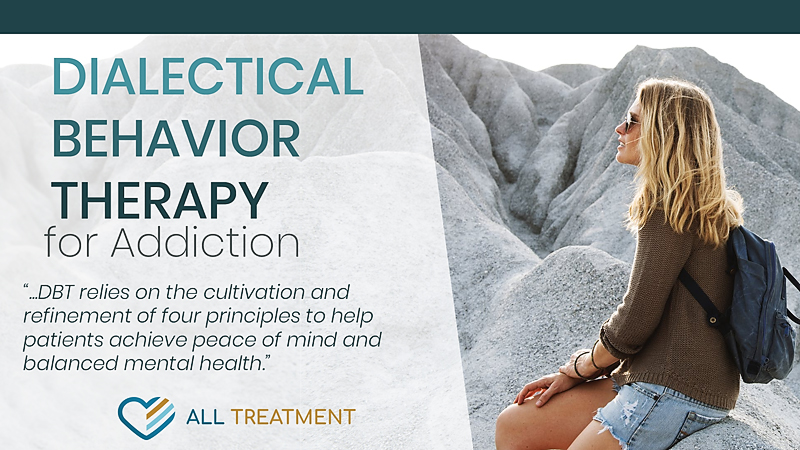Dialectical Behavior Therapy (DBT) for Addiction

Medically reviewed by: Amelia Hasenohrl Lpc CHt
Ms. Hasenohrl is a Licensed Professional Counselor with over 27 years of experience, specializing in helping clients overcome anxiety, panic disorder and the fear that prevents them from effectively managing their everyday lives.
Read About DBT Treatment For Addiciton
List Of All DBT Rehab Centers Nearby
Dialectical Behavior Therapy (DBT) for Addiction
Dialectical behavioral therapy (DBT) is a staple of modern addiction treatment and an incredibly effective component of behavioral rehab. It is one of the most commonly utilized therapeutic modalities and is available in both inpatient and outpatient treatment paradigms. DBT is commonly used to treat borderline personality disorder, suicidal ideations, and more. The primary goal of the technique is to help participants identify the triggers that lead to toxic and dysfunctional thought patterns that could trigger substance use. In an addiction treatment context, DBT is administered alongside group therapy, individualized counseling, and other types of cognitive behavioral therapy (CBT).
What Happens during Dialectical Behavioral Therapy?
DBT involves a collaborative therapy approach between participants and trained therapists. The process stresses empowerment, self-realization, and identification of problematic patterns of thinking that lead to and sustain drug and alcohol abuse.
DBT requires significant buy-in from participants as they’re expected to use the tools they gain from the therapy outside of treatment. DBT is administered through multiple weekly treatment sessions, homework exercises, and ongoing group therapy, during which patients develop healthy and proactive problem-solving behaviors to address the issue that arise in treatment.
DBT therapists are trained in this clinical specialization and can help patients extract the most out of this therapy.
Four Elements of Dialectical Behavioral Therapy
Generally speaking, DBT relies on the cultivation and refinement of four principles to help patients achieve peace of mind and balanced mental health:
- Mindfulness – Nonjudgmental self-realization allows patients to identify the evolution of harmful thought patterns. Core mindfulness skills are an essential building block of the DBT process.
- Interpersonal Effectiveness – This area prompts patients to examine their relationships with others and how the condition for which they’re receiving DBT has factored into their ability to interact with others. Patients utilize the skills and coping mechanisms they learn in DBT to improve their communication, emotional contextualization, and understanding of others. Some of the practical behavioral tools gained through interpersonal effectiveness include politely refusing others when their requests are difficult to satisfy and asking others for help in a mature, healthy, and tactful way. The process is meant to identify and anticipate potentially problematic interpersonal dynamics and work toward techniques to effectively communicate within them.
- Distress Tolerance – Operating on the initial premise that stress, pain, and inconvenience are inherent parts of life, DBT’s distress tolerance component helps patients effectively and safely process these unpleasant elements without exacerbating their conditions. Much of distress tolerance is geared toward helping patients develop healthy and critical yet nonjudgmental responses to external stimuli. It teaches patients to accept certain types of unpleasant realities without internalizing them and consuming their whole lives. Relying heavily on effectively dealing with a crisis, four sets of crisis-survival strategies are taught: distracting, self-soothing, improving the moment, and thinking of pros and cons.
- Emotional Regulation – This tenet of DBT guides participants toward taking an emotional inventory to identify, catalog, and label their feelings while identifying obstacles to change them. It also helps patients to react to stressful situations based on analyses and objective examination rather than pure emotion. Emotional regulation piggybacks on distress tolerance while increasing positive emotional elements and increasing mindfulness of patients’ current emotional states in moments of personal distress and crisis.
DBT participants address these issues through treatment sessions and independent practice in their everyday lives.
How Effective is Dialectical Behavioral Therapy?
Data from the American Foundation for Suicide Prevention (AFSP) indicates that DBT has great potential to reduce the risk of self-harm and to help patients gain better control of their emotions. Multiple data, including one study from the University of Washington, points to the clinical efficacy of DBT in co-occurring addiction and mental disorder.
This therapy very naturally dovetails with the ongoing clinical and mental health needs of those recovering from addiction. By addressing, identifying, and cataloging negative emotions, patients can better recognize them as they emerge and draw a line to these emotions and the urge to use drugs or alcohol. If you or a loved one is struggling with drug or alcohol use disorder, dialectical behavioral therapy may be ideal for you as you endeavor to reclaim your life from addiction.
Resources:
- afsp.org – Dialectal Behavioral Therapy (DBT) Actually Change the Way the Brain Works?
- ncbi.nlm.nih.gov – Dialectical Behavior Therapy for Substance Abusers


